Introduction
One of the priorities of today’s ecologists, biotechnologists, community activists, and environmentalists is the problem of microplastic pollution. Microplastics are a consequence of macroplastic pollution of natural environments, whether aquatic or terrestrial ecosystems. As a result of the long-term action of physical, mechanical, and light forces, gradual degradation of large plastic particles into individual fragments of microscopic size takes place. The central thesis of this paper is that microplastic contaminants, despite being so small, have severe detrimental effects on complex environmental security. The report is a practical, topical piece, full of scientific insights and evidence relevant to the agenda of the past two years. Hence, the report can be seen as a comprehensive, critical summary of the problem of microplastics contamination.
Microplastics: Background
Traditionally, communities have not dealt with microplastics because their size precludes effective industrial use of such materials. On the contrary, individuals generally interact with medium-sized plastics during their lifetime: this includes polyethylene materials for food and liquids, polypropylene construction materials and toys, and polyethylene glycol in cosmetic products. In reality, the number and composition of synthetic plastics used in industry are much broader.
It is noteworthy that the emergence of the first plastics is associated with the name of the British inventor Alexander Parks. In 1855, Parks created celluloid as a type of the first artificial plastic material, which has wide application in the music, children’s, and photo industries (Loishyn et al., 2020). Turning to Figure 1, however, shows a slightly different situation: the mention of plastics in print products has only become most relevant in the last seventy years, from which one can conclude that plastics have only become actively used since this period. This approximation is entirely consistent with objective data stating that by 2021 global production of industrial plastics had increased exponentially from the 1950s (Tiseo, 2021). From all of this, it is reasonable to conclude that humanity is actively using plastics in the home and is constantly investing in finding and producing new plastics.
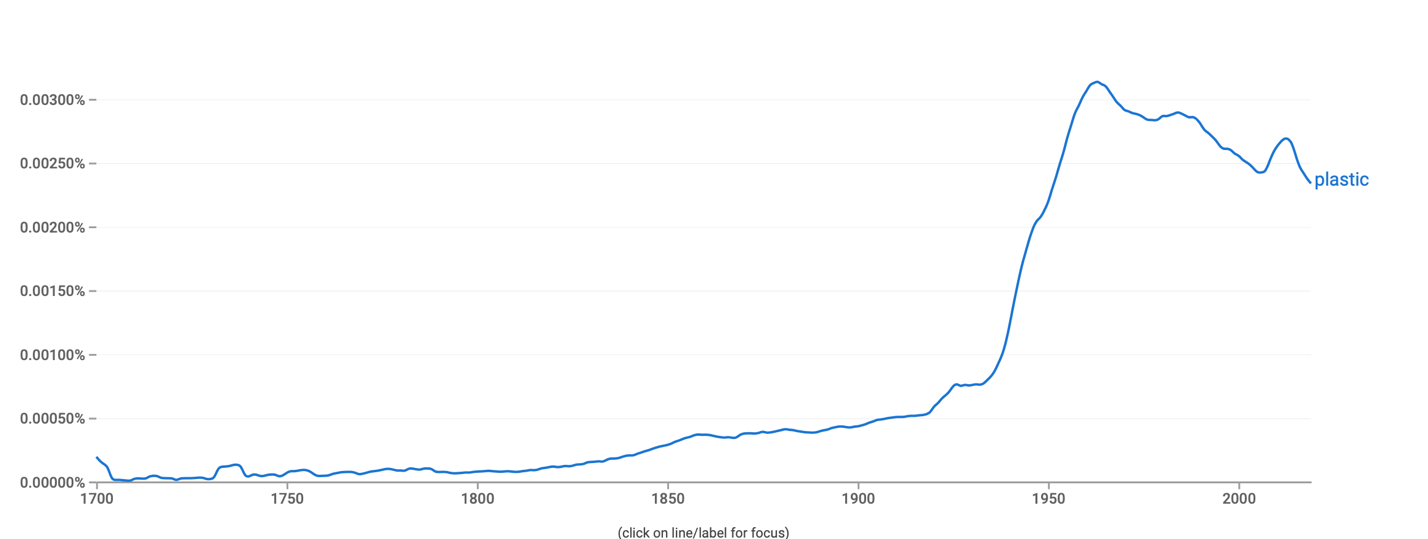
Humankind actively produces and even recycles plastic, but large amounts of it still end up in natural habitats. There is reliable data proving that the annual amount of plastic pollution entering the oceans is eight million tons (Parker, 2019). The primary sources of plastic entering the world’s ocean waters are obvious: unauthorized industrial and household waste discharges, poaching, sewage, and wastewater, and any natural disasters, whether a tsunami or urban flooding (Ritchie, 2021). Plastic also contaminates land areas through illegal dumping and unauthorized landfills. Regardless of the specific channel through which plastic enters the natural environment, large fragments of plastic end up there, which in itself already poses a threat to the ecological safety of local inhabitants.
However, not only macroplastic but also what it turns into has a severe threat to the environment. It is known that plastic has a relatively low density, so empty fragments of plastic float freely on the water surface, creating an obstacle to the rays of incident sunlight (Alsina et al., 2020). Denser plastics may sink to the bottom or float in the water column, given the increasing density gradient of seawater closer to the bottom. Thus, plastic products end up in all layers of ocean water, as shown in Figure 2. In turn, when plastic particles are exposed to the ocean for long periods of time, they are affected by the mechanical force of wave friction, abrasion due to chemical decomposition of polymers, and exposure to direct sunlight: all this leads to the degradation of macroplastics into individual, microscopic particles, called microplastic particles.
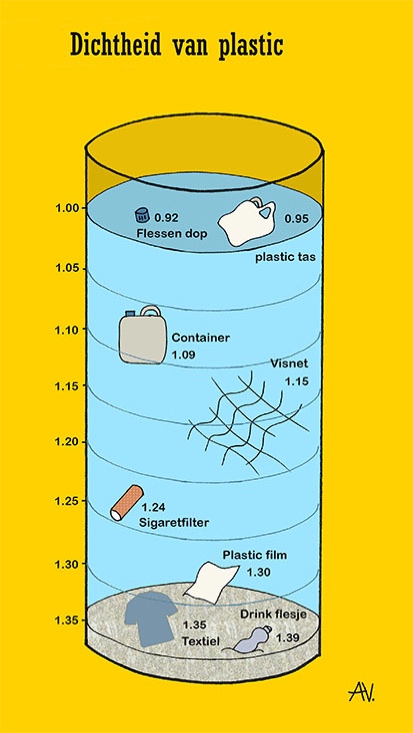
Thus, microplastics are commonly referred to as the product of the natural decomposition of plastic materials. Based on the name, each microplastic fragment has a critical small size that is indistinguishable to the human eye: to be more precise, the size of microplastic particles is usually no larger than 5 nm (Liitschwager, 2019). In reality, the size of a precise particle is not a constant number but rather expresses itself as a function of time, the type of plastic being degraded, and the type of degradation. In other words, there are a large number of microplastics of various sizes in ocean waters and on land, as shown in Figure 3. Academically, it is correct to think of microplastics as materials of a complex nature because, due to the self-organizing mechanism, such particles have a wide variety of shapes and properties (Kooi & Koelmans, 2019). Figures 4 and 5 clearly show this trend: there is a different distribution in the aquatic environment for microplastic particles of different sizes.
In addition, the frequency of occurrence of microplastic contaminants is a function of their density: the lower the density of plastic, the more frequently they are contaminants. It is also fair to recognize that microplastics include not only secondary production fragments resulting from the crushing of macroparticles but also specially synthesized products. Industrial microscopic-sized plastics have essential applications in the purification of solid or gaseous mixtures from impurities, in the production of plastic powders, in cosmetology and architecture, and in laboratory research (Stanley, 2019). While it is much easier to identify the source of contaminants and chemical composition for particles explicitly made, identifying the primacy of the found sample seems impossible when examining the composite composition of microplastic plugging.
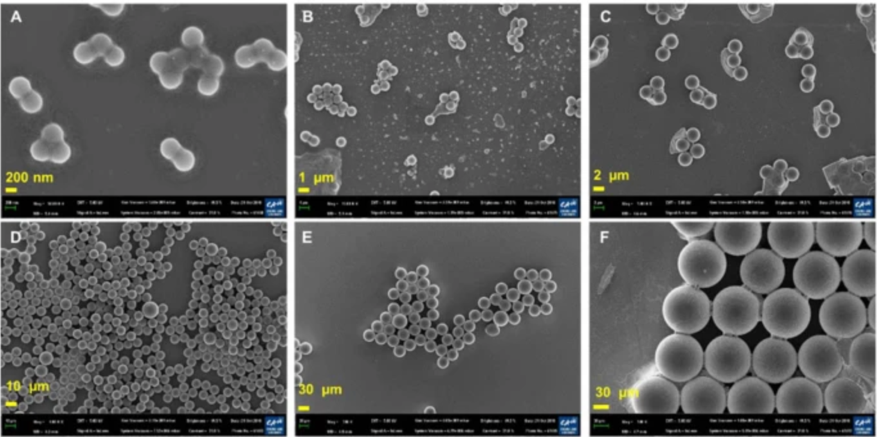
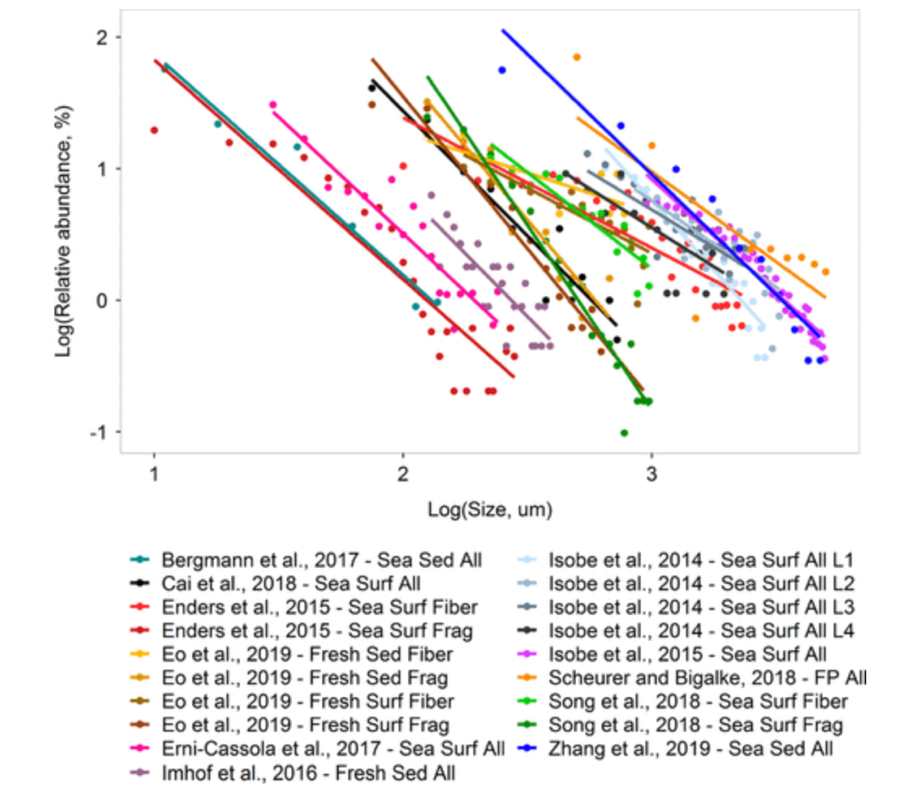
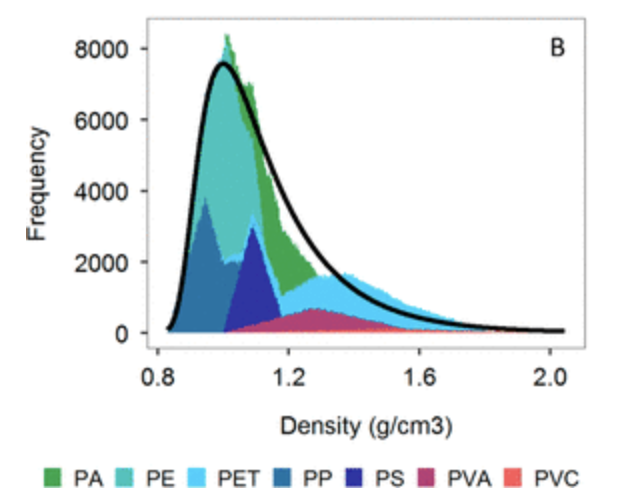
It is interesting that the problem of microplastic contaminants is comparatively new but already has high interest among the academic community. For specifics, Figure 6 reflects a chronogram of scholarly citations and publications of materials using the keyword “microplastics”: it is noticeable that interest in this issue has only become relevant in the last ten years, with the number of citations and publications increasing dramatically. At the same time, it is pertinent to consider Figure 7, which shows the main knowledge sectors within which thematic research papers are published. It is noticeable that microplastic research takes place in various fields of knowledge, which means that the problem of microplastic contaminants is widespread.
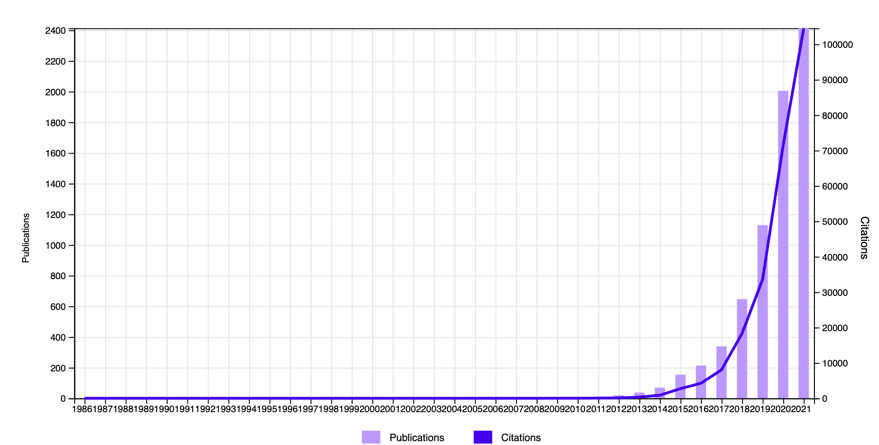
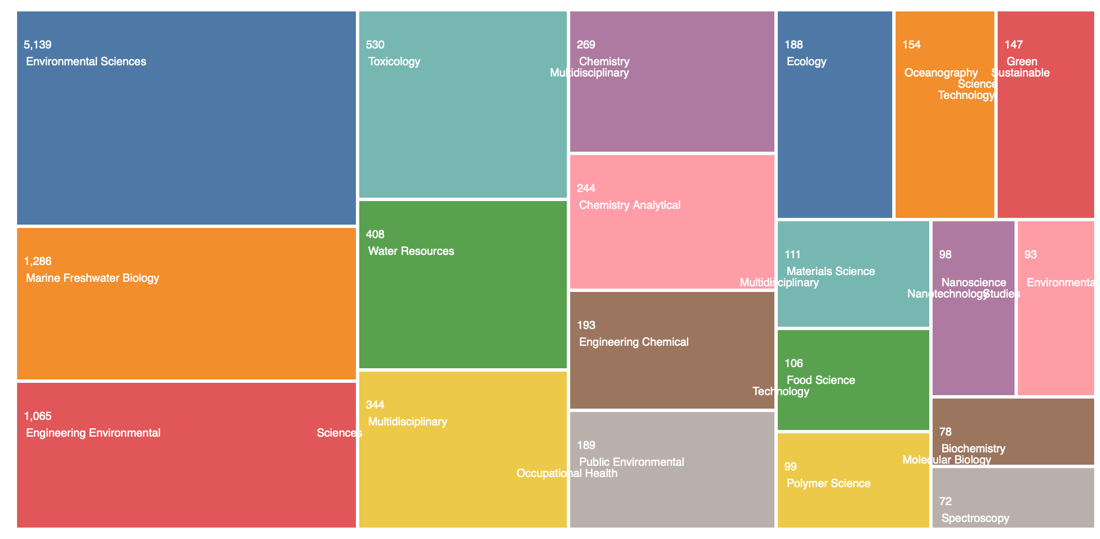
Threats from the Presence of Microplastics
Thus, microplastics are an integral part of natural ecosystems, which means that their presence in aquatic and terrestrial environments makes a very measurable environmental contribution to them. There are several proven effects that allow microplastic contaminants to be classified as negative environmental factors. Many of the threats described below are non-obvious but still pose a risk to pre-natural ecological communities. In this discussion, it is essential to reiterate that the issue of microplastics is still too new to the academic community to provide accurate, unbiased data covering all regions of the planet. A critical description of the destructive short- and long-term effects of microplastic pollution forms the subject of this section.
Intake into the Digestive Tract
Regarding microplastic particles, one of the most obvious negative factors is the assumption that microplastics, when ingested with food into the digestive tracts of marine and soil animals, can significantly degrade their quality of life. Some of the most popular headlines and titles for newspaper and academic articles are the claim that microplastic contaminants are found deep in trophic chains, which becomes evidence of migration of contamination through ecosystem connections of species. This, in turn, poses a particular danger to human communities, given the food value of marine life: fish, shellfish, turtles, and algae. The main danger, in this case, is obvious: hydrobionts that have inadvertently ingested plastic enter the human body with food, where they are also capable of deposition.
Since humans are, in certain senses, super-predators, the migration of microplastics to higher levels proves little possible. In addition, one can expect that plastic can enter the human body not only through ingestion but also through skin contact and through the inhalation of microscopic plastic dust. Nevertheless, it is not so much the levels of plastic migration as the likelihood of plastic accumulation in the human body that is crucial for biological researchers. By now, the academic community tends to believe that conclusive evidence for the toxicity of microplastic particles to the human body has not yet been gathered (Prata et al., 2020). Any of the claims are always based solely on assumptions about how the human body works and the activity of the immune system, but proving this is still difficult.
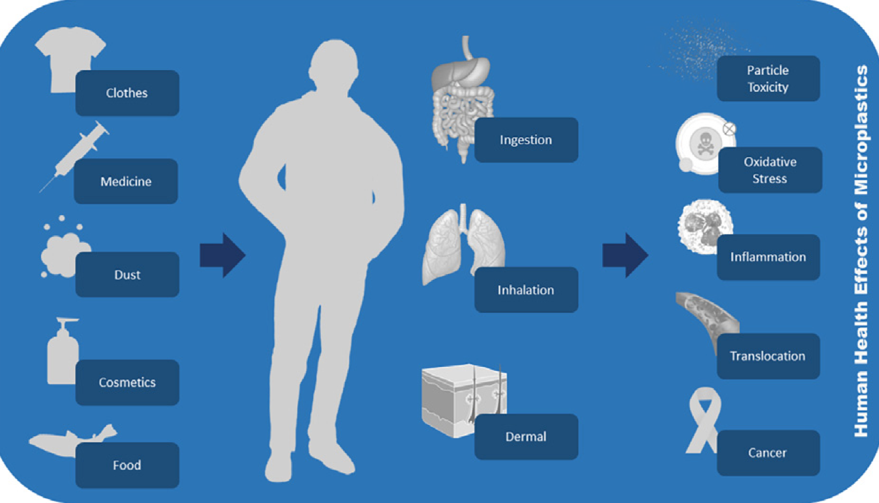
At the same time, it is essential to understand that microplastic particles entering the body of especially small animals can cause physical discomfort. In particular, the accumulation of the largest microplastic particles can block the digestive passages of animals and zooplankton, thereby preventing the free passage of food. Microplastic fragments have been shown to cause animals to eat less, with resulting effects on reproductive ability (Lim, 2021). As a consequence, microplastics have an additional danger. Of equal importance in the discussion of microplastic accumulation is the deposition of these particles in birds. Studies confirm that microplastic debris has been found in most Pacific shore birds: this was probably due to such birds feeding on fish from waters that are high in microplastic deposits (Carlin et al., 2020). In addition, seabirds are known to have a tendency to mistake colored fragments of plastic sediments for food, thereby absorbing macroplastic particles.
As a result of exposure to gastric juices and enzymes, these birds can likely break down plastic into micro fragments, which in turn can poison the bird’s body. The introduction of microplastic particles into young seabirds has been shown to have serious negative long-term health consequences (Leahy, 2019). At the same time, it should be understood that most seabirds are colonial animals, especially during breeding periods. The guano released in this process, as a valuable agricultural, natural excreta, may contain excess plastic contaminants and thus has an immediate danger to the plants that are fertilized by the guano as well (Hamilton et al., 2021). Thus, although only a few examples of the migration of microplastic particles in an ecosystem have been considered, it can already be said that it is appropriate to introduce a natural cycle term for such contaminants.
Adsorption Properties of Microplastics
One of the greatest threats to microplastics is their ability to absorb substances and subsequently release them into the external environment. It is well known that microplastics are often used for industrial purposes, and their unique physical and chemical properties allow plastic materials to be used as containers for transporting toxic liquids, including oil (Zanolli, 2020; Gautam et al., 2020). However, this phenomenon has consequences: over time, plastics absorb the liquids and gases with which they have been in contact. This is realized due to the presence of large intermolecular voids in the polymer chain of the plastic, as shown in Figure 9.
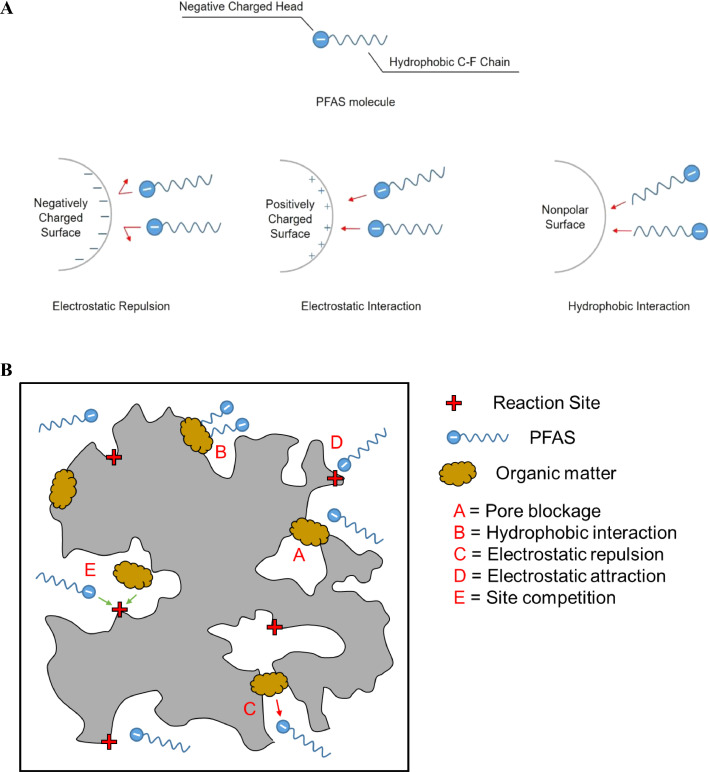
The mechanism of adsorption of toxic substances on the surface of microplastic is well understood. It has been shown that this occurs through the electrostatic charges of the polymer chains (Joo et al., 2021). Thus, microplastic contaminants in natural ecosystems can be sources of emission of harmful and toxic environmental pollutants. This is most dangerous for organismal systems in which microplastics act in the role of a parasite. However, there is still no consensus on this issue, and instead, a consensus of scientists continues to conduct research to determine the potential harm of microplastics as a source of toxin delivery (Lim, 2021). It is very likely that if such particles are contaminated with contaminants, these contaminations are easily washed away by water or enzymes in the organismal environment, but all this requires additional expertise.
Microplastics and Climate Change
Not the most obvious destructive effect of microplastics is to contribute to dramatic climate change. Microplastic pollution is not limited to aquatic or terrestrial environments; in fact, microplastic particles are almost everywhere, including in the form of dust, which inhabits the air (Q. Zhang et al., 2020). Microplastics in the air can create a scattering effect for the sun’s rays, as a result of which photons do not reach the Earth’s surface or do not leave it (X. Zhang et al., 2020). On the other hand, microplastics can absorb some of the wavelengths like greenhouse gases, which means that such small particles can contribute to global warming. Obviously, such extrapolations are still scientific hypotheses, and it takes time to test them qualitatively. However, it is already clear that this has the potential to become a severe problem to environmental security.
Conclusion
In conclusion, the problem of microplastic contamination is an essential part of environmental safety. There is now strong evidence that microplastics are found everywhere: in air, water, land, and, most importantly, in organisms. However, researchers are still unable to reach a consensus on the dangers of microplastic contaminants. While some evidence of microplastic toxicity has been shown for small animals and zooplankton, insufficient evidence of harm from microplastic particles to the human body has been found. For this reason, the overall conclusion is that microplastics are an important environmental safety issue, but their toxicity still requires additional, broader research.
References
Alsina, J. M., Jongedijk, C. E., & van Sebille, E. (2020). Laboratory measurements of the wave‐ induced motion of plastic particles: Influence of wave period, plastic size and plastic density. Journal of Geophysical Research: Oceans, 125(12), 1-17.
Carlin, J., Craig, C., Little, S., Donnelly, M., Fox, D., Zhai, L., & Walters, L. (2020). Microplastic accumulation in the gastrointestinal tracts in birds of prey in central Florida, USA. Environmental Pollution, 264, 1-9.
Gautam, A., Mata, T. M., Martins, A. A., & Caetano, N. S. (2020). Evaluation of Areca palm renewable options to replace disposable plastic containers using life cycle assessment methodology. Energy Reports, 6, 80-86.
Hamilton, B. M., Bourdages, M. P., Geoffroy, C., Vermaire, J. C., Mallory, M. L., Rochman, C. M., & Provencher, J. F. (2021). Microplastics around an Arctic seabird colony: Particle community composition varies across environmental matrices. Science of The Total Environment, 773, 1-10.
Hwang, J., Choi, D., Han, S., Jung, S. Y., Choi, J., & Hong, J. (2020). Potential toxicity of polystyrene microplastic particles. Scientific Reports, 10(1), 1-12.
Joo, S. H., Liang, Y., Kim, M., Byun, J., & Choi, H. (2021). Microplastics with adsorbed contaminants: Mechanisms and treatment. Environmental Challenges, 3, 1-16.
Kooi, M., & Koelmans, A. A. (2019). Simplifying microplastic via continuous probability distributions for size, shape, and density. Environmental Science & Technology Letters, 6(9), 551-557.
Leahy, S. (2019). Seabirds that eat plastic—and live—have major health problems. NG.
Liitschwager, D. (2019). Microplastics. NG.
Lim, X. Z. (2021). Microplastics are everywhere — but are they harmful? Nature.
Loishyn, A. A., Tkach, I. M., Chornyi, V. S., Tyshchenko, M. H., Tarasenko, N. M., & Biletskyi, O. (2020). Analysis of Plastic Waste Processing Methods. TEM Journal, 9(4), 1460-1466.
Parker, L. (2019). The world’s plastic pollution crisis explained. NG.
Plastic can be found everywhere in the ocean. (2019). Utrecht University.
Prata, J. C., da Costa, J. P., Lopes, I., Duarte, A. C., & Rocha-Santos, T. (2020). Environmental exposure to microplastics: An overview on possible human health effects. Science of the Total Environment, 702, 1-9.
Ritchie, H. (2021). Where does the plastic in our oceans come from? OWD.
Tiseo, I. (2021). Global plastic production 1950-2020. Statista.
Zhang, Q., Xu, E. G., Li, J., Chen, Q., Ma, L., Zeng, E. Y., & Shi, H. (2020). A review of microplastics in table salt, drinking water, and air: direct human exposure. Environmental Science & Technology, 54(7), 3740-3751.
Zhang, Y., Liang, J., Zeng, G., Tang, W., Lu, Y., Luo, Y.,… & Huang, W. (2020). How climate change and eutrophication interact with microplastic pollution and sediment resuspension in shallow lakes: A review. Science of the Total Environment, 705, 1-9.
Stanley, M. (2019). Microplastics. NG.
Zanolli, L. (2020). Are plastic containers safe for our food? The Guardian.